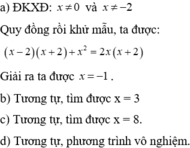Giải các phương trình sau:
a)
b)
c)
d)
Hãy nhập câu hỏi của bạn vào đây, nếu là tài khoản VIP, bạn sẽ được ưu tiên trả lời.



a) \(\sqrt {2{x^2} + x + 3} = 1 - x\)
Bình phương hai vế của phương trình ta được:
\(2{x^2} + x + 3 = 1 - 2x + {x^2}\)
Sau khi thu gọn ta được \({x^2} + 3x + 2 = 0\). Từ đó x=-1 hoặc x=-2
Thay lần lượt hai giá trị này của x vào phương trình đã cho ta thấy cả hai giá trị \(x = - 1;x = - 2\) đều thỏa mãn
Vậy phương trình có tập nghiệm \(S = \left\{ { - 1; - 2} \right\}\)
b) \(\sqrt {3{x^2} - 13x + 14} = x - 3\)
Bình phương hai vế của phương trình ta được:
\(3{x^2} - 13x + 14 = {x^2} - 6x + 9\)
Sau khi thu gọn ta được \(2{x^2} - 7x + 5 = 0\). Từ đó \(x = 1\) hoặc \(x = \frac{5}{2}\)
Thay lần lượt hai giá trị này của x vào phương trình đã cho ta thấy không có giá trị nào của x thỏa mãn
Vậy phương trình vô nghiệm.

a) Ta có: \(\left|x^2-x+2\right|-3x-7=0\)
\(\Leftrightarrow\left|x^2-x+2\right|=3x+7\)
\(\Leftrightarrow x^2-x+2=3x+7\)(Vì \(x^2-x+2>0\forall x\))
\(\Leftrightarrow x^2-x+2-3x-7=0\)
\(\Leftrightarrow x^2-4x-5=0\)
\(\Leftrightarrow x^2-5x+x-5=0\)
\(\Leftrightarrow x\left(x-5\right)+\left(x-5\right)=0\)
\(\Leftrightarrow\left(x-5\right)\left(x+1\right)=0\)
\(\Leftrightarrow\left[{}\begin{matrix}x-5=0\\x+1=0\end{matrix}\right.\Leftrightarrow\left[{}\begin{matrix}x=5\\x=-1\end{matrix}\right.\)
Vậy: S={5;-1}
bạn giải giúp mình câu b nữa với
mai mình phải nộp bài rồi!!!![]()

a.\(x^2-25=8\left(5-x\right)\)
\(\Leftrightarrow\left(x-5\right)\left(x+5\right)-8\left(5-x\right)=0\)
\(\Leftrightarrow\left(x-5\right)\left(x+5\right)+8\left(x-5\right)=0\)
\(\Leftrightarrow\left(x-5\right)\left(x+13\right)=0\)
\(\Leftrightarrow\left[{}\begin{matrix}x=5\\x=-13\end{matrix}\right.\)
b.\(\dfrac{x-2}{x+2}-\dfrac{2\left(x-11\right)}{x^2-4}=\dfrac{3}{x-2}\) ; \(ĐK:x\ne\pm2\)
\(\Leftrightarrow\dfrac{\left(x-2\right)\left(x-2\right)-2\left(x-11\right)}{\left(x-2\right)\left(x+2\right)}=\dfrac{3\left(x+2\right)}{\left(x-2\right)\left(x+2\right)}\)
\(\Leftrightarrow\left(x-2\right)^2-2\left(x-11\right)=3\left(x+2\right)\)
\(\Leftrightarrow x^2-4x+4-2x+22=3x+6\)
\(\Leftrightarrow x^2-9x+20=0\)
\(\Leftrightarrow\left[{}\begin{matrix}x=5\left(tm\right)\\x=4\left(tm\right)\end{matrix}\right.\)

a) \(\sqrt {2{x^2} - 14} = x - 1\quad \left( 1 \right)\)
ĐK: \(x - 1 \ge 0\,\, \Leftrightarrow \,\,x \ge 1.\)
\( \Rightarrow \) TXĐ: \(D = \left[ {1; + \infty } \right)\)
\(\begin{array}{l}\left( 1 \right)\,\, \Leftrightarrow \,\,{\left( {\sqrt {2{x^2} - 14} } \right)^2} = {\left( {x - 1} \right)^2}\\ \Leftrightarrow \,\,2{x^2} - 14 = {x^2} - 2x + 1\\ \Leftrightarrow \,\,{x^2} + 2x - 15 = 0\\ \Leftrightarrow \,\,\left[ {\begin{array}{*{20}{c}}{x = 3}\\{x = - 5}\end{array}} \right.\end{array}\)
Nhận thấy \(x = 3\) thỏa mãn điều kiện
Vậy nghiệm của phương trình \(\left( 1 \right)\) là: \(x = 3\)
b) \(\sqrt { - {x^2} - 5x + 2} = \sqrt {{x^2} - 2x - 3} \quad \left( 2 \right)\)
ĐK: \(\left\{ {\begin{array}{*{20}{c}}{ - {x^2} - 5x + 2 \ge 0}\\{{x^2} - 2x - 3 \ge 0}\end{array}} \right.\,\, \Leftrightarrow \,\,\frac{{ - 5 - \sqrt {33} }}{2} \le x \le - 1.\)
\( \Rightarrow \) TXĐ: \(D = \left[ {\frac{{ - 5 - \sqrt {33} }}{2}; - 1} \right].\)
\(\begin{array}{l}\left( 2 \right)\,\, \Leftrightarrow \,\,{\left( {\sqrt { - {x^2} - 5x + 2} } \right)^2} = {\left( {\sqrt {{x^2} - 2x - 3} } \right)^2}\\ \Leftrightarrow \,\, - {x^2} - 5x + 2 = {x^2} - 2x - 3\\ \Leftrightarrow \,\,2{x^2} + 3x - 5 = 0\\ \Leftrightarrow \,\,\left[ {\begin{array}{*{20}{c}}{x = 1}\\{x = - \frac{5}{2}}\end{array}} \right.\end{array}\)
Nhận thấy \(x = - \frac{5}{2}\) thỏa mãn điều kiện
Vậy nghiệm của phương trình \(\left( 2 \right)\) là: \(x = - \frac{5}{2}\)

\(a,\\ \Leftrightarrow3x-x=10-6\\ \Leftrightarrow2x=4\\ \Leftrightarrow x=2\\ b,\\ \Leftrightarrow\left(x-2\right)\left(x+1\right)=0\\ \Leftrightarrow\left[{}\begin{matrix}x-2=0\\x+1=0\end{matrix}\right.\\ \Leftrightarrow\left[{}\begin{matrix}x=2\\x=-1\end{matrix}\right.\)
\(a,\Leftrightarrow3x-x=10-6\\ \Leftrightarrow2x=4\\ \Leftrightarrow x=\dfrac{4}{2}=2\)
Vậy phương trình có tập nghiệm S = \(\left\{2\right\}\)
\(b,\Leftrightarrow\left(x+1\right)\left(x-2\right)=0\\ \Leftrightarrow x+1=0\) hoặc \(\Leftrightarrow x-2=0\)
\(\Leftrightarrow x=-1\) \(\Leftrightarrow x=2\)
Vậy phương trình có tập nghiệm S = \(\left\{-1;2\right\}\)

b: =>(x-5)2+6(x-5)=0
=>(x-5)(x+1)=0
=>x=5 hoặc x=-1
c: \(\Leftrightarrow x^2-x+2=2\)
=>x(x-1)=0
=>x=0(loại) hoặc x=1(nhận)

a) \(\sqrt {2 - x} + 2x = 3\)\( \Leftrightarrow \sqrt {2 - x} = 3 - 2x\) (1)
Ta có: \(3 - 2x \ge 0 \Leftrightarrow x \le \frac{3}{2}\)
Bình phương hai vế của (1) ta được:
\(\begin{array}{l}2 - x = {\left( {3 - 2x} \right)^2}\\ \Rightarrow 2 - x = 9 - 12x + 4{x^2}\\ \Leftrightarrow 4{x^2} - 11x + 7 = 0\\ \Leftrightarrow \left[ \begin{array}{l}x = 1\left( {TM} \right)\\x = \frac{7}{4}\left( {KTM} \right)\end{array} \right.\end{array}\)
Vậy tập nghiệm của phương trình là \(S = \left\{ 1 \right\}\)
b) \(\sqrt { - {x^2} + 7x - 6} + x = 4\)\( \Leftrightarrow \sqrt { - {x^2} + 7x - 6} = 4 - x\) (2)
Ta có: \(4 - x \ge 0 \Leftrightarrow x \le 4\)
Bình phương hai vế của (2) ta được:
\(\begin{array}{l} - {x^2} + 7x - 6 = {\left( {4 - x} \right)^2}\\ \Leftrightarrow - {x^2} + 7x - 6 = 16 - 8x + {x^2}\\ \Leftrightarrow 2{x^2} - 15x + 22 = 0\\ \Leftrightarrow \left[ \begin{array}{l}x = 2\left( {TM} \right)\\x = \frac{{11}}{2}\left( {KTM} \right)\end{array} \right.\end{array}\)
Vậy tập nghiệm của phương trình là \(S = \left\{ 2 \right\}\)

(a) Điều kiện: \(\left\{{}\begin{matrix}x+1\ge0\\x-5>0\end{matrix}\right.\Leftrightarrow\left\{{}\begin{matrix}x\ge-1\\x>5\end{matrix}\right.\Rightarrow x>5\).
Phương trình tương đương: \(\sqrt{x+1}=2\sqrt{x-5}\)
\(\Leftrightarrow x+1=4\left(x-5\right)\Leftrightarrow x=7\left(TM\right)\).
Vậy: \(S=\left\{7\right\}.\)
(b) Phương trình tương đương: \(x^2-1=8\)
\(\Leftrightarrow x^2=9\Leftrightarrow x=\pm3\).
Vậy: \(S=\left\{\pm3\right\}\)
a: ĐKXĐ: x+1>=0 và x-5>0
=>x>5
\(\dfrac{\sqrt{x+1}}{\sqrt{x-5}}=2\)
=>\(\sqrt{\dfrac{x+1}{x-5}}=2\)
=>\(\dfrac{x+1}{x-5}=4\)
=>4x-20=x+1
=>3x=21
=>x=7
b: ĐKXĐ: \(x\in R\)
\(\sqrt[3]{x^2-1}=2\)
=>x^2-1=8
=>x^2=9
=>x=3 hoặc x=-3

\(a,\Leftrightarrow x^2+2x+1+2x+3-2\sqrt{2x+3}+1=0\\ \Leftrightarrow\left(x+1\right)^2+\left(\sqrt{2x+3}-1\right)^2=0\\ \Leftrightarrow\left\{{}\begin{matrix}x=-1\\2x+3=1\end{matrix}\right.\Leftrightarrow x=-1\left(N\right)\)
\(b,\Leftrightarrow3x^2+3x-2\sqrt{x^2+x}=0\left(x\le-1;x\ge0\right)\\ \Leftrightarrow3x\left(x-1\right)-2\sqrt{x\left(x+1\right)}=0\\ \Leftrightarrow\sqrt{x\left(x+1\right)}\left(3\sqrt{x\left(x-1\right)}-2\right)=0\\ \Leftrightarrow\left[{}\begin{matrix}x\left(x-1\right)=0\\\sqrt{x\left(x-1\right)}=\dfrac{2}{3}\end{matrix}\right.\\ \Leftrightarrow\left[{}\begin{matrix}x=0\\x=1\\x^2-x-\dfrac{4}{9}=0\end{matrix}\right.\\ \Leftrightarrow\left[{}\begin{matrix}x=0\\x=1\\9x^2-9x-4=0\left(1\right)\end{matrix}\right.\)
\(\Delta\left(1\right)=81-4\left(-4\right)\cdot9=225\)
\(\Leftrightarrow\left[{}\begin{matrix}x=0\\x=1\\x=\dfrac{9-15}{18}\\x=\dfrac{9+15}{18}\end{matrix}\right.\Leftrightarrow\left[{}\begin{matrix}x=0\left(N\right)\\x=1\left(N\right)\\x=-\dfrac{1}{3}\left(L\right)\\x=\dfrac{4}{3}\left(N\right)\end{matrix}\right.\Leftrightarrow\left[{}\begin{matrix}x=0\\x=1\\x=\dfrac{4}{3}\end{matrix}\right.\)

\(a,=>x^3-2x^2+4x+2x^2-4x+8-x^3+2x-15=0\)
\(< =>2x-7=0< =>x=\dfrac{7}{2}\)
b,\(=>x\left(x^2-25\right)-\left(x+2\right)\left(x^2-2x+4\right)-3=0\)
\(< =>x^3-25x-x^3+2x^2-4x-2x^2+4x-8-3=0\)
\(< =>-25x-11=0\)
\(< =>x=-0,44\)